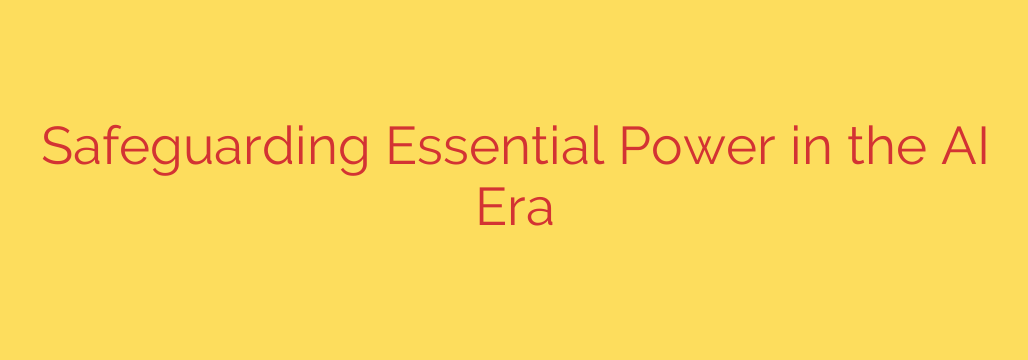
AI’s Insatiable Appetite for Power: Securing Our Critical Infrastructure
Artificial intelligence is no longer a futuristic concept; it’s a driving force behind our daily lives. From complex data analysis to generative art and advanced business automation, AI’s capabilities are expanding at a breathtaking pace. However, this revolution has an unseen cost: an unprecedented demand for electrical power. This immense energy consumption is placing a significant strain on our power grids, creating a critical new challenge for national and corporate security.
As AI models become more sophisticated, the data centers that train and run them are consuming energy on a scale comparable to entire cities. This concentration of high-power demand makes these facilities, and the electrical infrastructure that supports them, prime targets for disruption. Protecting this essential power supply is no longer just an operational issue—it’s a foundational component of modern security.
The Growing Vulnerabilities in a Power-Hungry World
The reliance on a stable and continuous power supply exposes organizations and nations to a new set of intertwined risks. The vulnerabilities aren’t just about a single server failing; they concern the potential for widespread disruption that could cripple economic and social functions. These threats exist on two primary fronts: the digital and the physical.
Cyber Threats: The systems that manage and distribute power, known as Operational Technology (OT), were historically isolated. Today, they are increasingly connected to IT networks to improve efficiency, creating new pathways for cyberattacks. A successful cyberattack on a power grid or a data center’s power management system could lead to catastrophic blackouts. Malicious actors, from ransomware groups to state-sponsored entities, understand that disrupting power is one of the most effective ways to cause widespread chaos.
Physical Threats: Beyond the digital realm, the physical components of our power infrastructure remain vulnerable. This includes everything from substations and transmission lines to the backup generators at a data center. Physical sabotage, extreme weather events intensified by climate change, and even supply chain disruptions for critical replacement parts can sever the power essential for AI operations. A targeted physical attack on a few key nodes could have a cascading effect across the entire grid.
Actionable Strategies for Safeguarding Essential Power
To counter these evolving threats, organizations must adopt a proactive and multi-layered approach to power security. Simply hoping for the best is not a viable strategy. The focus must be on resilience, redundancy, and intelligence.
Implement a Defense-in-Depth Security Strategy
A single layer of security is insufficient. A robust defense combines physical security measures (like access control and surveillance) with strong cybersecurity protocols. This includes network segmentation to isolate critical OT systems from business IT networks, continuous monitoring for anomalous activity, and regular vulnerability assessments. Assume that a breach is possible and build systems that can detect, contain, and recover from an intrusion.Invest in Power Redundancy and Backup Systems
Reliance on a single power source is a critical failure point. Every essential facility must be equipped with an uninterruptible power supply (UPS) and backup generators. A UPS provides instant, battery-based power to bridge the crucial seconds or minutes between a grid failure and the activation of generators. Regular testing and maintenance of these backup systems are non-negotiable to ensure they function when needed most. For ultimate resilience, exploring options like microgrids, which can operate independently from the main grid, is becoming increasingly necessary.Enhance Situational Awareness with Advanced Monitoring
You cannot protect what you cannot see. Deploying advanced monitoring tools provides real-time visibility into both power consumption and security status. These systems can detect subtle fluctuations in voltage or unusual network traffic that could signal an impending failure or an ongoing cyberattack. Using AI-powered analytics to predict maintenance needs or identify emerging threats allows security teams to move from a reactive to a proactive posture.Secure the Supply Chain
Your security is only as strong as its weakest link, and that often includes your supply chain. Critical components for power systems, from transformers to control system software, can be compromised before they are ever installed. It is vital to thoroughly vet all suppliers and insist on transparency regarding the origin and security of their products. This includes demanding secure coding practices for any software and ensuring hardware has not been tampered with in transit.
Powering the Future, Responsibly
The advancement of artificial intelligence offers immense potential for human progress. However, this progress depends entirely on a stable, secure, and resilient energy foundation. Protecting our critical power infrastructure is not just an IT or facilities management task; it is a strategic imperative. As we continue to build a more intelligent and connected world, we must ensure that the power that fuels it is fortified against the threats of today and tomorrow.
Source: https://datacentrereview.com/2025/09/protecting-critical-power-in-the-ai-revolution/








